Sea Scout Awards and Recognitions
In addition to the Sea Scout advancement program, there are many additional awards and recognitions that Sea Scouts, and often times Scouters, can earn in their time with the program.
Small Boat Handler

This recognition can be a basic training for small boat handling skills. It is particularly useful for Ships that do not participate in traditional Sea Scout Advancement programs. Helpful information about these skills can be found in the Sea Scout Manual.
Qualified Seaman

This recognition can be a basic training for skills with larger vessels. It is particularly useful for Ships that do not participate in traditional Sea Scout Advancement programs. Helpful information about these skills can be found in the Sea Scout Manual.
Long Cruise Badge

This award is for both youth and adults in the Sea Scouting program to recognize their times spent on Long Cruises. Youth must be at least at the Ordinary rank to be awarded this badge, there are no additional requirements for adults to earn the badge. Requirements are a long cruise of at least two works on a vessel provided by the Council or Ship. A private vessel may also count if approved by the Skipper. Additional two week or longer Long Cruises can be represented by a red arc on the outside of the badge. Wehn 5 arcs have been earned those five can be replaced by a single white arc.If a two week cruise is not possible, then smaller shorter cruises may be combined to equal the 14 days to satisfy the requirement.
Sea Scout Marksmanship Award
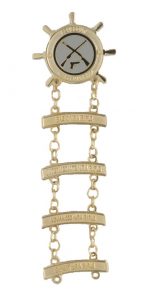
This Award can keep the Ship and Scouts going with activities, especially if parts of the year do not lend themselves to aquatic activities. Scouts cna choose a discipline to qualify in from; rifle, shotgun, or pistol. They will start by earning the Basic Shooter requirements, and may progress to; Intermediate Shooter, Advanced Shooter, and Expert Shooter status by completing increasingly more challenging requirements. Bars denoting your Shooter level can be added to the award to show which level you have attained.
Sea Scout Leadership Award

This award can be presented at the Council, National Service Territory, or National level to leaders, either youth or adults, who have given exceptional contributions to the Sea Scout program.
America's Boating Club Finley Sea Scout Service Award
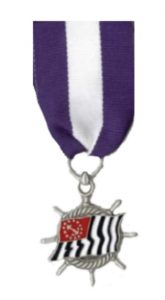
This award recognizes Sea Scouts or Scouters that are also members of America’s Boating Club. Recipients are nominated for giving exceptional service through; civic involvement, educational achievement, and active participation in both organizations.
National Outdoor Award
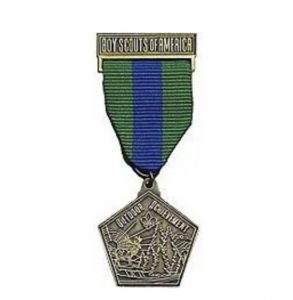
Open to Sea Scouts, as well as Scouts BSA and Venturers, the National Outdoor Award is awarded to Scouts who demonstrate a commitment to being in the outdoors. The award has several subcategories and you can qualify by satisfying the requirements for any one area. Additional areas can be earned and are recognized by small banners that surround the original patch. The areas are; Camping, Hiking, Aquatics, Conservation, Riding, and Adventure.
National Outdoor Awards badges may be earned in the following areas:
Camping. A Scout, Sea Scout, or Venturer may earn the National Outdoor Badge for Camping upon successfully completing the following requirements:
- Earn the First Class rank, Sea Scout Apprentice rank, or complete Venturing Ranger Award requirements 1–6.
- Complete the Camping merit badge requirements.
- Complete the requirements for two of the following three: Cooking merit badge or Ranger Cooking core; First Aid merit badge or Ranger First Aid core; Pioneering merit badge.
- Complete 25 days and nights of camping—including six consecutive days (five nights) of camping (Sea Scouts may be on a boat), approved and under the auspices and standards of the Boy Scouts of America—including nights camped as part of requirements 1 through 3 above. Scouts must complete six consecutive days (five nights) of the 25 nights at a BSA accredited resident camp.
A gold device may be earned for each additional 25 nights of camping. A silver device is earned for each additional 100 nights of camping. The youth may wear any combination of devices totaling his or her current number of nights camping.
Hiking. A Scout, Sea Scout, or Venturer may earn the National Outdoor Badge for Hiking upon successfully completing the following requirements:
- Earn the First Class rank, Sea Scout Apprentice rank, or complete Venturing Ranger Award requirements 1-6.
- Complete the requirements for one of the following: Hiking merit badge, Backpacking merit badge, or Venturing Ranger Backpacking elective.
- Complete the requirements for one of the following: Orienteering merit badge, Geocaching merit badge, or Venturing Ranger Land Navigation core requirement.
- Complete 100 miles of hiking, backpacking, snowshoeing, or cross country skiing under the auspices of the Boy Scouts of America, including miles hiked as part of requirements 2 and 3.
A gold device may be earned for each additional 50 miles hiked, backpacked, snowshoed, or skied as outlined in requirements 2 and 3. A silver device is earned for each additional 200 miles of hiking. The youth may wear any combination of devices totaling his or her current number of miles hiking.
Aquatics. A Scout, Sea Scout, or Venturer, may earn the National Outdoor Badge for Aquatics upon successfully completing the following requirements:
- Earn the First Class rank, Sea Scout Apprentice rank, or complete Venturing Ranger Award requirements 1-6.
- Complete the requirements for the Swimming merit badge and either Lifesaving merit badge or Venturing Ranger Lifesaver elective. (For Sea Scouts, swimming merit badge requirements are an Ordinary rank requirement, and lifesaving merit badge requirements are an Able rank requirement).
- Complete the requirements for the Mile Swim BSA Award.
- Complete the requirements for at least one of the following: Canoeing, Fishing, Fly-Fishing, Kayaking, Rowing, Scuba Diving, Small-Boat Sailing, Water Sports, or Whitewater merit badges or Ranger Award Fishing, Scuba or Watercraft electives. Complete at least 25 hours of on-the-water time, applying the skills that you learned in the merit badge or Ranger elective.
- Complete at least 50 hours of any combination of swimming, canoeing, fishing, fly-fishing, kayaking, rowing, scuba, small-boat sailing, stand up paddleboarding, water sports, or whitewater activity under the auspices of the Boy Scouts of America, including time spent in requirements 2 through 4.
A gold device may be earned for each additional 25 hours of aquatics activity listed in requirement 5. A silver device is earned for each additional 100 hours of aquatics activity. The youth may wear any combination of devices totaling his or her current number of hours of aquatics activity.
Conservation. A Scout, Sea Scout, or Venturer may earn the National Outdoor Badge for Conservation upon successfully completing the following requirements:
- Earn the First Class rank, Sea Scout Apprentice rank, or complete Venturing Ranger Award requirements 1-6.
- Demonstrate the safe use of five of the following conservation tools: pick or pickax; shovel or spade; ax; bow saw; cross-cut saw; prybar; sledge hammer; loppers or shears; fire rake or McLeod; and/or Pulaski. Discuss the ethical use of the tools you chose.
- Complete the requirements for the following:
a. Environmental Science merit badge or Sustainability merit badge or both Venturing Ranger Conservation core and Ecology elective
b. Soil and Water Conservation merit badge
c. One of the following merit badges: Fish and Wildlife Management, Forestry, or Mammals
- Complete 25 hours of conservation work under the auspices and standards of the Boy Scouts of America, including hours worked as part of requirements 1 through 3.
A gold device may be earned for each additional 25 hours of conservation work. A silver device is earned for each additional 100 hours of conservation work (for example, the first silver device is earned at 125 total hours of conservation work). Youth may wear any combination of devices totaling his or her current number of hours of conservation work.
Riding. A Scout, Sea Scout, or Venturer may earn the National Outdoor Badge for Riding upon successfully completing the following requirements:
- Earn the First Class rank, Sea Scout Apprentice rank, or complete Venturing Ranger Award requirements 1-6.
- Complete the requirements for at least one of the following:
a. Cycling merit badge or Ranger Cycling/Mountain Biking elective and 100 miles of cycling
b. Horsemanship merit badge or Ranger Equestrian elective and 20 miles of horseback riding
c. Motorboating merit badge or Ranger Watercraft elective and 100 miles of motor boating
d. Skating merit badge or Ranger Winter Sports elective and 20 miles of skating
3. Complete 200 miles of riding activities, including cycling, stock riding, skating, motor boating, mountain boarding, (including ATV or PWC riding at an approved council program), under the auspices of the Boy Scouts of America, including the miles in requirement 2.
A gold device may be earned for each additional 100 miles of riding set forth in requirement 3. A silver device is earned for each additional 400 miles of riding. The youth may wear any combination of devices totaling his or her current number of miles of riding.
Adventure. A Scout, Sea Scout, or Venturer may earn the National Outdoor Badge for Adventure upon successfully completing the following requirements:
- Earn the First Class rank, Sea Scout Apprentice rank, or complete Venturing Ranger Award requirements 1-6.
- Complete the requirements for one of the following: Wilderness Survival, Search and Rescue, or Emergency Preparedness merit badges or Ranger Wilderness Survival core, Ranger Emergency Preparedness core, or Ranger First Aid elective.
- Complete 10 of any combination or repetition of the following adventure activities under the auspices of the Boy Scouts of America:
a. A backpacking trip lasting three or more days and covering more than 20 miles without food resupply
b. A canoeing, rowing, or sailing trip lasting three or more days and covering more than 50 miles without food resupply
c. A whitewater trip lasting two or more days and covering more than 20 miles without food resupply
d. A climbing activity on open rock, following Climb On Safely principles, that includes camping overnight
e. Earn the National Historic Trails Award.
f. Earn the 50-Miler Award.
g. Attend any national high-adventure base or any nationally recognized local high-adventure or specialty-adventure program.
Items 3a–g may be repeated as desired. A single activity that satisfies multiple items in 3a–g may be counted as separate activities at the discretion of the unit leader. Similarly, a single activity that doubles an item in 3a–d may be counted as two activities at the discretion of the unit leader. A gold device may be earned for each additional five activities. A silver device is earned for each additional 20 activities. The Scout may wear any combination of devices totaling his current number of activities.
Boardsailing BSA

1. Before fulfilling the following requirements, you must successfully complete the BSA swimmer classification test.
2. Review how each point of BSA Safety Afloat applies to boardsailing.
3. Explain precautions for the following environmental factors: dying wind, high wind, offshore winds, currents, waves, and lightning.
4. Discuss the prevention, recognition, and treatment of the following health concerns that could arise while boardsailing: hypothermia, sunburn, dehydration, and heat exhaustion.
5. Properly rig and prepare the sailboard you are using. Identify each of the following: uphaul, outhaul, downhaul, cleat, leach, tack, clew, foot, luff, skeg, centerboard, wishbone boom, and universal. Explain luffing. Explain how to steer the sailboard by adjusting the center of effort.
6. Demonstrate your ability to uphaul the sail, find the neutral position to the wind (sail luffing), and control the board’s position with foot movement.
7. With supervision from your instructor, sail a course that involves beating, reaching, and running. Change direction by tacking into the wind.
Mile Swim
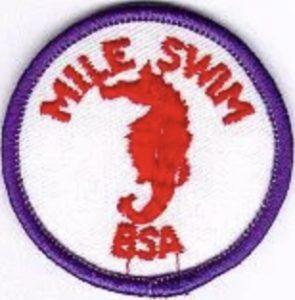
1. Explain how regular exercise contributes to good health and why swimming is one of the best forms of exercise.
2. Tell what precautions and procedures a swimmer and escort must follow for distance swimming over open water.
3. Under the supervision of a currently qualified counselor, participate in four hours of training and preparation for distance swimming (one hour a day maximum).
4. Swim one mile over a measured course that has been approved by the counselor supervising the swim.
Kayaking BSA
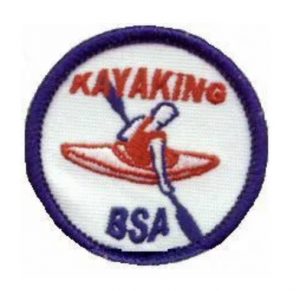
1. Before fulfilling the following requirements, successfully complete the BSA swimmer test.
2. Do the following:
a. Describe various types of kayaks and how they differ in design, materials, and purpose.
b. Name the parts of the kayak you are using for this exercise.
c. Demonstrate how to choose an appropriately sized kayak paddle and how to position your hands.
3. Do the following:
a. Tell what precautions must be taken for a safe trip afloat.
b. Demonstrate how to select and properly fit a life jacket.
c. Explain the importance of safety equipment such as life jackets, air bags, grab loops, and helmets.
4. Demonstrate your ability to aid yourself and others in the event of a capsize:
a. Capsize your kayak in water at least seven feet deep, perform a wet exit if necessary, and swim the boat to shore.
b. With assistance, if needed, ready the capsized craft for use.
c. Show how to approach a capsized paddler in your kayak and tow him to shore.
d. While upright in your kayak, right a capsized kayak, empty it of water, and assist the paddler aboard without returning to shore.
5. As a solo paddler, demonstrate the following:
a. Entering and launching a kayak from shore or dock
b. Landing or docking and exiting a kayak
c. Forward stroke
d. Sweep stroke
e. Reverse sweep
f. Draw stroke
g. Rudder stroke
h. Back stroke
6. As a solo paddler, do the following:
a. Paddle forward in a reasonably straight line.
b. Move the kayak sideways to the right and to the left.
c. Pivot 360 degrees to the right and left.
d. Stop the kayak.
BSA Lifeguard
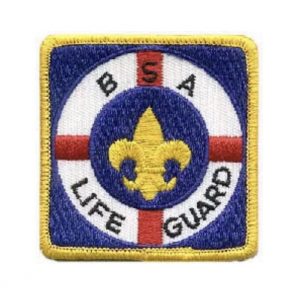
Prerequisites
Before doing requirements 6 through 26, complete the following:
1. Submit proof of age and BSA Registration. You must be at least 15 years old to participate.
2. Submit written evidence of fitness for swimming activities (signed health history).
3. Swim continuously for 550 yards in good form using the front crawl or breaststroke or a combination of either, but swimming on the back or side is not allowed.
4. Immediately following the above swim, tread water for two minutes with the legs only and the hands under the armpits.
5. Starting in the water, swim 20 yards using a front crawl or breaststroke, surface dive 7 to 10 feet, retrieve a 10-pound object, surface, swim on your back with the object 20 yards back to the starting point with both hands holding the object, and exit the water, all within 1 minute, 40 seconds.
Requirements
Complete the following requirements within a 120-day period:
6. Show evidence of current training in American Red Cross First Aid and American Red Cross CPR/AED for the Professional Rescuer or equivalent.
7. Show evidence of current training in the BSA online module for Safe Swim Defense.
8. Attend and actively participate in all activities, presentations, demonstrations, and skill sessions involving lifeguard behavior, duties, responsibilities, surveillance, intervention and water rescue as prescribed in the BSA Lifeguard Instructor Manual.
9. Demonstrate reaching assists from the deck using an arm, a rescue tube, and a pole.
10. Demonstrate throwing assists using a throw bag and a ring buoy with a line attached. Throw each device such that the line lands within reach of an active subject 30 feet from shore.
11. Demonstrate:
a) Rescue of an active subject in deep water using a rescue board, kayak, rowboat, canoe, or other rescue craft that would be available at your local facility.
b) Repeat for a passive subject.
12. Demonstrate an entry and front approach with a rescue tube to an active subject in deep water 30 feet away from shore. Position the rescue tube to support the subject and then assist the subject to safety, providing direction and reassurance throughout.
13. Demonstrate an entry and rear approach with a rescue tube to an active subject in deep water 30 feet away from shore. Secure and support the subject from behind and then move the subject to safety, providing direction and reassurance throughout.
14. Demonstrate use of a rescue tube to assist two subjects grasping each other. Secure, support and reassure both subjects. With the assistance of a second guard, calm and separate the subjects and move them to safety.
15. Demonstrate both front and rear head-hold escapes from a subject’s grasp. BSA Lifeguard Instructor Manual — 9
16. Demonstrate an entry and front approach with a rescue tube to a face-down passive subject 30 feet away at or near the surface in deep water. Use a wrist roll to position the subject face-up on the rescue tube, tow to safety, and remove them from the water with assistance within 90 seconds. Immediately perform a primary assessment and demonstrate one-person CPR for 3 minutes.
17. Demonstrate an entry and rear approach with a rescue tube to a face-down passive subject 30 feet away at or near the surface in deep water. Position the subject face-up, tow to safety and remove them from the water with assistance within 90 seconds. Immediately perform a primary assessment and demonstrate two-person CPR for 3-minutes.
18. In shallow water, demonstrate in-water ventilation of an unconscious subject when prompt removal from the water is not possible. Open the airway, position the mask, and simulate ventilations.
19. Demonstrate an entry and approach with a rescue tube for use when a passive subject is submerged face-down at or near the bottom in 6 to 8 feet of water. Bring the subject to the surface and tow to the nearest point of safety.
20. Remove a subject from the water using each of the following techniques in the appropriate circumstances with the aid of a second rescuer:
a) Extrication at the edge of a pool or pier using a backboard
b) Walking assist
c) Beach drag
21. Participate in multiple-rescuer search techniques appropriate for a missing subject in murky water:
a) Line search in shallow water
b) Underwater line search in deep water without equipment
c) Underwater line search in deep water with mask and fins
22. Demonstrate in-line stabilization for a face-down subject with suspected spinal injury in very shallow water (18 inches or less).
23. Demonstrate in-line stabilization for a suspected spinal injury in shallow water (waist to chest deep):
a) For a face-up subject
b) For a face-down subject
24. Demonstrate in-line stabilization for a suspected spinal injury in deep water, swim the subject to shallow water, confirm vital signs, and with the assistance of others, remove the subject from the water using a backboard with straps and a head immobilization device.
25. Correctly answer 80 percent of the questions on the BSA Lifeguard knowledge test covering the course material. Review any incomplete or incorrect answers.
26. Serve as a lifeguard, under supervision, for at least two separate BSA swimming activities for a combined time of two hours. Afterward, discuss the experience with the lifeguarding instructor.
BSA Stand Up Paddleboarding

1. Review the BSA Safety Afloat policy. Explain to your instructor how this applies to stand up paddleboarding.
2. Before fulfilling other requirements, successfully complete the BSA swimmer test: Jump feet first into water over the head in depth, level off, and begin swimming. Swim 75 yards in a strong manner using one or more of the following strokes: sidestroke, breaststroke, trudgen, or crawl; then swim 25 yards
using an easy, resting backstroke. The 100 yards must be completed in one swim without stops and must include one sharp turn. After completing the swim,
rest by floating.
3. Explain safety considerations for stand up paddleboarding in the following environments: lake, moving water, white water, open ocean, ocean surf.
4. Review the characteristics of life jackets most appropriate for stand up paddleboarding and understand why one must always be worn while paddling. Then demonstrate how to select and fit a lifejacket for stand up paddleboarding.
5. Describe the correct type of leash to wear in the appropriate water venues.
6. Name and point out:
a. The major parts of a stand up paddleboard
b. The parts of a paddle for stand up paddleboarding
7. Discuss:
a. The different types of stand up paddleboards
b. How to correctly size and hold a paddle for stand up paddleboarding
8. Using a properly outfitted stand up paddleboard, demonstrate the following:
a. How to safely carry a stand up paddleboard
b. How to safely paddle away from a dock or shoreline (on knees)
c. How to stand and balance on a board in the neutral position
d. How to appropriately fall off a board
e. How to remount the board
f. Forward stroke
g. Back stroke
h. Forward sweep
i. Reverse sweep
j. Draw stroke
k. One self-rescue technique—lay on your stomach and paddle with your hands
9. With supervision from your instructor, paddle a course that involves:
a. A straight line for 25 yards and stop within one board length
b. A figure 8
c. Moving abeam to the right 10 feet and to the left 10 feet
White Water Rafting BSA

1. Before doing the following requirements, successfully complete the BSA swimmers test.
2. Do the following:
a. Name the parts of a whitewater raft.
b. Describe differences between a paddle raft and an oar-powered raft.
c. Explain the importance of perimeter lines used on whitewater rafts.
d. Demonstrate how to choose an appropriate size paddle.
e. Demonstrate how to select and properly fit a life jacket.
f. Demonstrate how to select and properly fit a helmet.
g. Discuss the use of throw ropes in rescuing overboard paddlers.
h. Discuss common river hazards including rocks, strainers, broaching, standing waves, hydraulics, and foot entrapment.
3. Explain the importance of safety equipment used in whitewater rafting including throw ropes, helmets, and life jackets. Also discuss appropriate clothing and footwear for a whitewater rafting trip.
4. Under proper supervision and appropriate conditions safely do the following:
a. Lift, carry, launch, and land an inflatable raft, with help, on calm or slow-moving water.
b. Sit in a raft as a paddler with proper foot position.
c. Swim a Class I rapid while wearing a life jacket, helmet and attire appropriate for the water temperature. Demonstrate defensive and aggressive swimming positions as possible.
d. Re-enter a raft from the water, with assistance if needed.
5. While on calm or slow-moving water, demonstrate the following strokes in an inflatable raft with at least one other paddler and on command of a qualified paddle captain:
a. Forward
b. Back
6. While on moving water up to Class I, demonstrate the following maneuvers with at least three other paddlers in an inflatable raft and on the command of a qualified paddle raft captain:
a. Turn left.
b. Turn right.
c. Paddle forward in a straight line for 50 feet.
d. Back paddle reasonably straight for 15 feet.
7. While on moving water up to Class I, demonstrate the following maneuvers with at least three other paddlers in an inflatable raft and on the command of a qualified paddle raft captain:
a. A front or a back ferry.
b. A shallow or a wide eddy turn.
c. A shallow or a wide peel out.
8. Participate in a whitewater rafting trip in up to Class III white water with a qualified paddle raft captain in each raft using a minimum of two rafts and for at least one hour’s duration.
SCUBA BSA
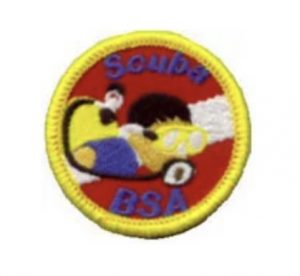
1. Before doing other requirements, successfully complete the BSA swimmer test. To begin the test, jump feet first into water over the head in depth, level off, and begin swimming. Swim 75 yards in a strong manner using one or more of the following strokes: sidestroke, breaststroke, trudgen, or crawl; then swim 25 yards using an easy, resting backstroke. The 100 yards must be completed in one swim without stops and must include at least one sharp turn. After completing the swim, rest by floating.
2. Discuss the importance of using the buddy system at all times while scuba diving. Explain that a dive buddy is there to assist with the donning and doffing
of equipment, to lend assistance in case of emergency, and to share in the underwater experience. Remember, always dive with a buddy—Never dive alone!
3. Review hazards associated with scuba diving, including causes of decompression incidents, and safety procedures to avoid them. Explain the importance of never using scuba equipment unless you are enrolled in a training exercise or have completed a diver certification program taught by a certified instructor.
4. State the purpose of the following pieces of basic diving equipment: mask, fins, BCD, BCD inflator, regulator, air gauge, and alternate air source.
5. Describe how to locate the air gauge, and explain how to recognize the “caution zone” on it.
6. Don and adjust mask, fins, snorkel, BCD, scuba, and weights with the assistance of a buddy, an instructor, or a certified assistant.
7. While underwater, demonstrate and recognize the following hand signals: OK?/OK!; Stop; Up; Down; Out of air; Come here; Ears not clearing; Slow down/
Take it easy; Something is wrong; Watch me; Check your air supply.
8. Inflate/deflate a BCD at the surface using the lowpressure inflator.
9. In shallow water, demonstrate proper compressed air breathing habits; remember to breathe naturally and not hold the breath.
10. Clear the regulator while underwater using both exhalation and purge-button methods, and resume normal breathing from it.
11. In shallow water, recover a regulator hose from behind the shoulder while underwater.
12. In shallow water, clear a partially flooded mask while underwater.
13. Swim underwater with scuba equipment while maintaining control of both direction and depth, properly equalizing the ears and mask to accommodate depth changes.
14. While underwater, locate and read submersible pressure gauge and signal whether the air supply is adequate or low based on the gauge’s caution zone.
15. Describe how to avoid hazardous aquatic life (ifapplicable to your confined water location).
Snorkeling BSA
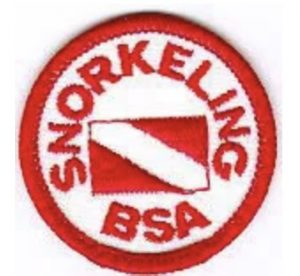
1. Before doing other requirements, successfully complete the BSA swimmer test: Jump feet first into water over the head in depth, level off, and begin swimming. Swim 75 yards in a strong manner using one or more of the following strokes: sidestroke, breaststroke, trudgen, or crawl; then swim 25 yards using an easy, resting backstroke. The 100 yards must be completed in one swim without stops and must include at least one sharp turn. After completing the swim, rest by floating.
2. Discuss the importance of using the buddy system at all times while snorkeling and list duties of a buddy, beginning with equipment checks.
3. Explain the function, fit, and selection of mask, fins, and snorkel. Discuss the use of inflatable flotation vests and life jackets when snorkeling in open water.
4. In confined, shallow water (about waist deep), demonstrate use of mask and snorkel:
a. Show how to prevent the mask from fogging and how to equalize pressure in mask, ears, and sinus cavities. With your head underwater, flood the mask, observe the effect on your vision, surface, and drain the water from the mask.
b. With your face in the water, breathe through the snorkel. Then submerge, surface, clear water from the snorkel, and resume free breathing without removing the snorkel from your mouth.
5. In confined, shallow water, demonstrate the use of swim fins: Do first using only fins, and then repeat with a mask and snorkel.
a. Fit and adjust fins to feet.
b. Walk with fins as if entering from a beach.
c. Swim at the surface (10 yards) and underwater (three yards) using the flutter kick.
d. Control direction without using hands while swimming with fins at the surface and underwater.
6. In confined, deep water (six to 12 feet), demonstrate:
a. Proper techniques for entering and exiting the water with snorkeling equipment from a dock or boat.
b. Headfirst and feet first surface dives, including proper body position for safe ascent and descent.
7. Show knowledge of snorkeling signals:
a. Demonstrate divers’ signs and signals, both audible and visual, for use at the surface and underwater.
b. Set out a diver down flag and explain its function.
8. In clear, confined water eight to 12 feet deep that has a firm bottom, while swimming with a buddy, use mask, fins, and snorkel to locate and recover an object from the bottom.
9. Demonstrate basic survival skills:
a. Float facedown for five minutes while breathing through a snorkel with a minimum of movement.
b. Demonstrate survival floating for five minutes without use of a snorkel.
c. Using fins, show how to tow an exhausted or unconscious buddy to safety.
10. Review and explain the eight points of Safe Swim Defense and BSA Snorkeling Safety. Explain training, preparations, and precautions required for snorkeling in open water. Explain environmental factors that affect snorkeling and discuss special precautions needed for oceans, streams, and lakes.
11. Explain pressure, buoyancy, and submerged optics and acoustics related to snorkel swimming and diving.
12. Discuss the effects of submersion on the body and how to handle potentially dangerous situations:
a. What is hyperventilation and how is it avoided?
b. What are the symptoms and consequences of hypothermia?
c. Why is CPR training recommended for those participatingin swimming and snorkeling activities?